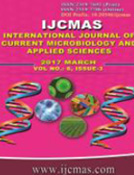


 National Academy of Agricultural Sciences (NAAS)
National Academy of Agricultural Sciences (NAAS)

|
PRINT ISSN : 2319-7692
Online ISSN : 2319-7706 Issues : 12 per year Publisher : Excellent Publishers Email : editorijcmas@gmail.com / submit@ijcmas.com Editor-in-chief: Dr.M.Prakash Index Copernicus ICV 2018: 95.39 NAAS RATING 2020: 5.38 |
To standardize the nitrogen scheduling in DSR, a field was conducted with different Basmati rice varieties with different nitrogen rates and splits at CCS Haryana Agricultural University, Regional Research Station at Karnal, India during rainy kharif seasons of 2014 and 2015. Nitrogen had significant positive effect on basmati rice crop resulting in improvement in plant height, number of tillers and effective tillers, grains/panicle, panicle length, 1000-grain weight, grain yield and straw yield with increase in dose from 90 to 100 and 110 kg ha-1 in succession. Also, the grain yield was further improved with increase in number of splits from three to four. Nitrogen at 110 kg ha-1 with four splits at 0, 20, 40, and 60 days after sowing was realized to be the optimum schedule for attaining maximum grain yield (49.3 & 50.2 q ha-1) and yield attributes. Among basmati varieties, highest grain yield (47.5 & 48.9 q ha-1) was recorded in HB-2 followed by PB-1121 (47.1 & 47.0 q ha-1), PB-1 (43.9 & 44.6 q ha-1) and PB-1509 (42.9 & 43.8 q ha-1) under direct seeding conditions.
 |
 |
 |
 |
 |